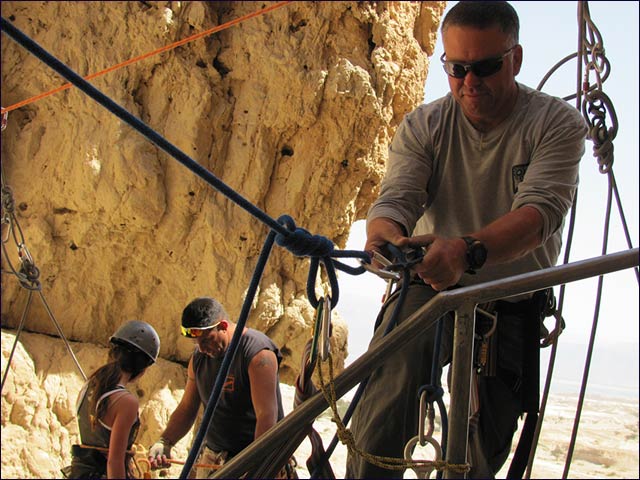By Sarah Carnvek
If you want to “feel” the country and really get a sense of its natural surroundings, then take a sportier route through Israel: canyoning (also known as canyoneering).
Though a small country geographically, Israel's topography varies every few minutes. In the north, there are forested highlands and fertile valleys; in the middle, coastal plains and a semitropical valley; and in the south, mountainous deserts.
While there are hundreds of trails to follow, Israelis have a fondness for adrenaline highs and extreme sports. And jumping off a cliff into a canyon fits this bill.
"Israelis like to explore, they like to do extraordinary things," says Adam Sela, founder of Challenging Experience jeep tours and wilderness activities. "Canyoning in Israel is uncomplicated. You can do it in one day."
Canyoning, of course, is all about accessing parts of nature that cannot otherwise be reached. The activity is actually a combination of different techniques that can include rappelling, climbing, walking, hiking, jumping and swimming.
Most of Israel's top canyoning spots are found in the Judean Desert but there are also options in the Golan Heights.
"Canyoning in Israel cannot be compared to canyoning in Utah or Arizona, but it does rival European spots," says Sela. "If you're in Israel and want to do canyoning then there are some nice places. And most of them are easily accessible."
By rope only
Sela recommends the Judean Desert’s Tamar Stream trail for starters. With gorgeous views, this canyon has a 20-meter cliff and can be descended with or without rappelling.

Canyoning in the Tamar Stream is a good starting point
Photo courtesy of Adam Sela "It's user friendly, not complicated and it's good because there are ladders on the obstacles," he says.
Other (more difficult) canyons include Tmarim - a canyon with 50-meter cliffs and a long hike to get there; Rachaf -- in the South Judean Desert with nine 28-meter cliffs for rappelling and a water pool for swimming; Chatzatzon – a difficult trail with steep rappelling; and Qumran - one of the prettiest canyons in the Dead Sea area, with four 32-meter cliffs.
There are also wet adventures in Israel's north. The Yehudiya canyon features a 30-meter-high rappel into water; and the Black Canyon, formed of volcanic rock, offers two 20-meter rappelling options down waterfalls or a zip-line down.
Though Israel is sunny most of the year, Sela says the season for canyoning runs between April and October. Winter flash floods in the desert are common off-season and extremely dangerous.
Safety first, then wheeee
Sela points out that Israelis may be known for taking risks and loving adventure, but stresses that safety always comes first.
No experience is needed when canyoning in Israel. But tour operators recommend that you should hire a guide. And in Israel, there's no such thing as going canyoning with an inexperienced guide.
"All instructors – from all the different touring companies – are trained and licensed. You don't have that in other parts of the world," says Sela, who in addition to running desert adventure tours also volunteers as a High Angle Alpine Rescue technician and paramedic with the Negev Highlands Search and Rescue Team.
"I know from travelling around the world that Israelis are more safety-conscious. All companies in Israel use the two-rope system. And if something should go wrong, Israel has great search-and-rescue teams."
Sela recommends that first-timers complete a regular rappelling experience before taking on a canyon to eliminate any potential height fears. After that, he says teenagers and upwards ("though I have taken younger kids") are good to go.
And though you might think canyoning in summer is a sweltering option, Sela says that most of the canyons are shaded and thus actually offer relief to a regular hiking option.
"The canyons are definitely cooler than the desert around them and there's usually a wind there, too," says Sela. "The Judean Desert is crossed by deep ravines. It is really beautiful."